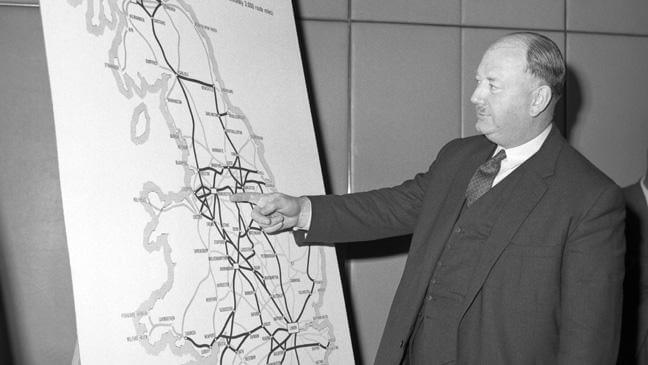Dr Richard Beeching is much maligned as the Chairman of the British Railways Board who wielded his axe, closing thousands of miles of railway and stations in the 1960s.
The jury is still out on whether his report ‘The Reshaping of British Railways’, published on the 27 March 1963 led to the decimation of the railway network or sowed the seeds which has allowed the industry to flourish in the 21st century.

The decline of rail’s fortunes in the 20th century had begun long before the Beeching report
Between the wars over 1,300 miles of unprofitable railway had been closed by the railway companies. The demands on rail made by WWII provided a brief respite from the closures, but between the nationalisation of the railways in 1948 and the publication of the Beeching Report in 1963 an additional 3,000 miles of railway had been withdrawn by the BR Regions themselves.
The Modernisation Plan of 1955
The British Transport Commission’s 1955 ‘Modernisation Plan’ had not revived the fortunes of the railway as it had hoped. The rise of car ownership and the road haulage of goods from the early 1950s was challenging rail’s supremacy. Beeching was brought into British Railways as a businessman and economist at a time when the British railway system was losing £100 million a year. His brief was to stem the losses and plan for the future of rail as part of a national transport system.
Lines that were saved are now crucial to the railway network and have seen major investment in the last 15 years.
The Beeching Report
There was controversy on how Beeching’s team went about gathering the statistics that would decide the fate of the 2363 stations and 5000 miles of track earmarked for closure in the Beeching Report. However for the first time a truly country wide view of the railway system was being defined; the Government was reshaping the British railway map to make national decisions for a nationalised industry.
Many lines were saved despite being named in the Beeching Report
Once the report was published, political, economic and social pressure was heaped on the government who ultimately decided whether a line or a station was to close. Many lines were saved despite being named in the Beeching Report and other services that did not appear were withdrawn. Some lines were closed to loss making passenger services, but remained open for freight. Recommendations made in the report closed local and rural branch lines to let the main lines prosper, allowing British Railways to focus on developing its InterCity and Freightliner businesses.
Its effects still influence the planning, investment and development on today’s railway
The Report obviously had a significant effect on the railway infrastructure we own and maintain today, and its effects still influence the planning, investment and development on today’s railway. Lines that were saved are now crucial to the railway network and have seen major investment in the last 15 years. Against a backdrop of rising demand for both passenger and freight services, Network Rail is investing in reinstating lines closed in the 1960s. Network Rail also works with over 60 Community Rail Partnerships to provide rural and local railways that are so important to the communities they serve.
Britain today has a thriving railway which is the fastest growing network in Europe, and it is busier now than at any time since the 1920s; despite Beeching – or because of him?